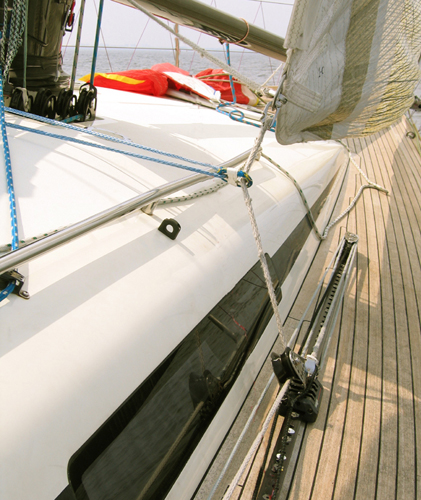ANDY_W
Active member
For reasons that I won't go into now, I am examining the possibility of moving the cap shroud chainplates closer to the mast.
At the same time the chainplates would be raised to be at the same level as the foot of the mast, moving them from their position on the deck to the side of the cabin.
I am hoping that someone here may be knowledgeable enough, and kind enough, to work out how the forces on the rigging would alter. I suspect that they would be greater but have no idea how much.
The following is how the system is now:
Sail area 540 sq ft Standing rigging is 1x19 strand wire
Mast is coachroof mounted
Mast foot to cap 36ft 3ins
Foot to spreaders 18ft
Spreaders to cap 18ft 3ins
Spreader end to mast 2ft 11ins
Cap shroud chainplates located 18 ins below mast foot vertically under spreader ends.
Proposed changes:
Spreaders shortened by 8ins to 2ft 3ins
Chainplates moved inboard by 8 ins and upwards by 18 ins remaining vertically under ( shortened ) spreader ends.
Cap shrouds shortened to match.
I am looking at the feasibility rather than the desirability so if anyone can help it would be much appreciated.
As ever, any or all contributions gratefully accepted.
At the same time the chainplates would be raised to be at the same level as the foot of the mast, moving them from their position on the deck to the side of the cabin.
I am hoping that someone here may be knowledgeable enough, and kind enough, to work out how the forces on the rigging would alter. I suspect that they would be greater but have no idea how much.
The following is how the system is now:
Sail area 540 sq ft Standing rigging is 1x19 strand wire
Mast is coachroof mounted
Mast foot to cap 36ft 3ins
Foot to spreaders 18ft
Spreaders to cap 18ft 3ins
Spreader end to mast 2ft 11ins
Cap shroud chainplates located 18 ins below mast foot vertically under spreader ends.
Proposed changes:
Spreaders shortened by 8ins to 2ft 3ins
Chainplates moved inboard by 8 ins and upwards by 18 ins remaining vertically under ( shortened ) spreader ends.
Cap shrouds shortened to match.
I am looking at the feasibility rather than the desirability so if anyone can help it would be much appreciated.
As ever, any or all contributions gratefully accepted.

